Social Protection
Context
The State of the World’s Cash 2020 report found:
- Working with, through and alongside social protection systems is now considered key to strengthening the humanitarian-development nexus and humanitarians are increasingly active in this space
- Practitioners find that the three biggest challenges to effective linkages are: (i) lack of coordination between the actors involved, (ii) social protection systems are not designed to respond to crises, (iii) humanitarian practitioners lack expertise in social protection
- Critically, there is no ‘one size fits all’ solution to linking CVA and social protection. Trade-offs between efficiency, effectiveness, accountability, and sustainability must be considered to ensure the best outcomes for people living in crisis and depends on context, existing systems, and timeframe. Linking will not always be appropriate and social protection systems may not meet all needs. In many contexts, in the short to medium term at least, humanitarian programming will be required to fill gaps.
Current Priorities
The CALP Network has invested intensely in this thematic area over the last few years. We will continue to work closely with the SPIAC-B Working group on linking humanitarian (cash) assistance and social protection (formerly the Grand Bargain Sub-Workstream on Social Protection) and with the SocialProtection.org platform and the Online Community Social Protection in Crisis Contexts to develop evidence, produce capacity building materials and provide technical support to coordination actors.
Community of Practice
SocialProtection.org hosts a dynamic and collaborative online community of practice (CoP) bringing together individuals from diverse backgrounds interested in expanding social protection in crisis-prone areas. The CoP offers a space to exchange documents, insights, and news in order to progress and learn together. Its inclusive and member-led approach offers organisations and individual members a forum to increase learning and outreach, facilitating the exchange of experiences and expanding knowledge. A discussion group hosted by dgroups.org complements these activities by connecting users rapidly via email.
SPACE
There are a wealth of relevant resources from ‘Social Protection Approaches To Covid-19: Expert Advice’ (SPACE) published in the CALP library.
Featured content

Linking Social Protection and Humanitarian Cash and Voucher Assistance
Report
There is a growing momentum and body of work around the idea of developing stronger links between humanitarian cash and voucher assistance (CVA) and social protection (SP). This Briefing Paper for the CALP Network, based on a literature review, a survey, and interviews, is intended to inform the CALP Network’s overall approach in this area, and subsequently its capacity building and...

Linking Social Protection and Humanitarian Cash
Blog Post
The case for social protection to help people cope with shocks has always been clear and never more obvious than during the current Covid-19 crisis. These issues are currently playing out in real time as governments, donors and aid agencies scramble to find ways to get more help to more people to cope with the economic consequences of illness and lockdown. As the virus starts to take hold in...

Linking Social Protection and humanitarian cash and voucher assistance (CVA) – what do we really know and where to start? Findings from the CALP Network commissioned high level briefing paper at the time of COVID-19
Webinar
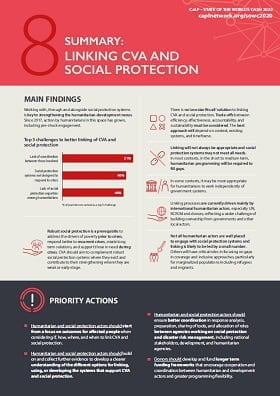
State of the World’s Cash 2020 Chapter 8 summary: Linking CVA and social protection
Report
Longstanding efforts to strengthen links between humanitarian CVA and social protection have been accelerated by the COVID-19 pandemic, with significant progress since the last report. CVA should aim to complement robust social protection systems where they exist and contribute to their strengthening where they are weak or early-stage. This chapter asks: ‘What opportunities and challenges...
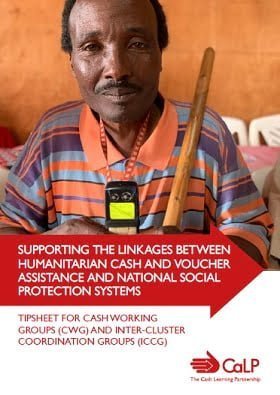
Supporting the Linkages Between Humanitarian Cash and Voucher Assistance and National Social Protection Systems
Report
This tipsheet aims to support country-level coordination efforts to strengthen the engagement between humanitarian coordination groups that implement cash and voucher assistance (CVA) and existing social
protection or disaster risk reduction coordination actors and groups. In particular, it seeks to offers inter-cluster and cash working group coordinators simple practical tips for engaging...
Case Studies

Linking CVA and Social Protection in the MENA Region – Crib sheet
Report
Building linkages between humanitarian cash and voucher assistance (CVA) and social protection (SP) has become an increasingly prominent topic over the past five years and the Middle East and North Africa (MENA) region has been at the centre of this evolution. The objective of this resource set (the crib sheet and 3, soon to be 6, regional case studies) is to ensure that the CALP Network...
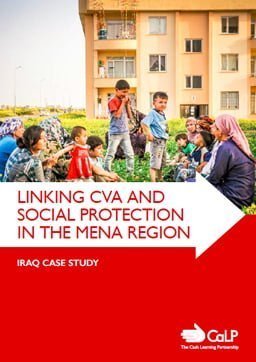
Linking CVA and Social Protection in the MENA Region – Iraq Case Study
Report
Building linkages between humanitarian cash and voucher assistance (CVA) and social protection (SP) has become an increasingly prominent topic over the past five years and the Middle East and North Africa (MENA) region has been at the centre of this evolution. The objective of this resource set (the crib sheet and 3, soon to be 6, regional case studies) is to ensure that the CALP Network...

Linking CVA and Social Protection in the MENA Region – Lebanon Case Study
Report
Building linkages between humanitarian cash and voucher assistance (CVA) and social protection (SP) has become an increasingly prominent topic over the past five years and the Middle East and North Africa (MENA) region has been at the centre of this evolution. The objective of this resource set (the crib sheet and 3, soon to be 6, regional case studies) is to ensure that the CALP Network...
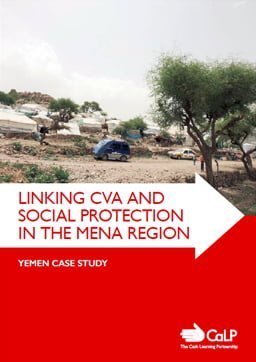
Linking CVA and Social Protection in the MENA Region – Yemen Case Study
Case Study
Building linkages between humanitarian cash and voucher assistance (CVA) and social protection (SP) has become an increasingly prominent topic over the past five years and the Middle East and North Africa (MENA) region has been at the centre of this evolution. The objective of this resource set (the crib sheet and 3, soon to be 6, regional case studies) is to ensure that the CALP Network...

Linking Cash and Voucher Assistance (CVA) and Social Protection – Occupied Palestinian Territories (OPT): Country Summary
Report
This country summary is part of a larger resource set, providing practitioners with examples of different approaches to linking CVA
and social protection.
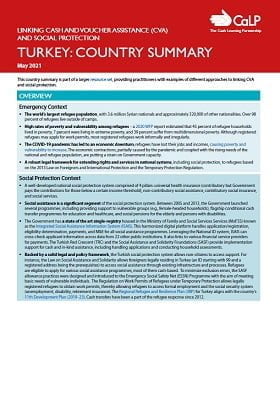
Linking Cash and Voucher Assistance (CVA) and Social Protection – Turkey: Country Summary
Report
This country summary is part of a larger resource set, providing practitioners with examples of different approaches to linking CVA
and social protection.
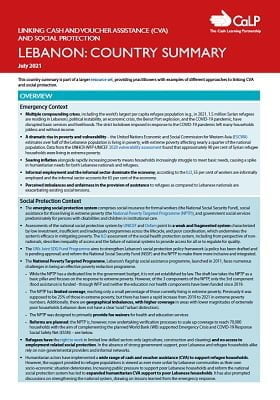
Linking Cash and Voucher Assistance (CVA) and Social Protection – Lebanon: Country Summary
Report
This country summary is part of a larger resource set, providing practitioners with examples of different approaches to linking CVA
and social protection.
Thematic lead
Latest

Enhancing Resilience and Restoring Agricultural Productive Capacity and Food Security through Social Protection in Indonesia – Emergency assistance for post-earthquake and tsunami recovery through cash assistance in Central Sulawesi
Case Study
In 2018, a series of earthquakes struck Indonesia’s Central Sulawesi Province, which is a major agricultural production centre in the country. The earthquakes triggered a tsunami and caused landslides with considerable damage and loss of life. Damages to the agricultural sector accounted alone for 40...

HNPW Linking humanitarian assistance and social protection – common principles and country experiences
Webinar recording
More and more people are living in contexts of protracted crises, driven by conflict, climate vulnerability and socio-economic fragility, requiring new ways of working together and stronger coherence between interventions across the HDP nexus. Linking HA and SP provides a clear entry point for development...

Linking humanitarian assistance and social protection – common principles and country experiences
Members event
About the webinar: More and more people are living in contexts of protracted crises, driven by conflict, climate vulnerability and socio-economic fragility, requiring new ways of working together and stronger coherence between interventions across the HDP nexus. Linking HA and SP provides a clear...

Cash Voucher Assistance, Social Protection and Cash Plus Programmes
Presentation
In this session, we examine the linkages between CVA and social protection and Cash Plus programmes. We closely follow a Case Study by Mercy Corps that looks into impact programs that combine cash interventions with vocational trainings on violence reduction.
In summary, we explore:
Linkages to...

Report Launch and Panel Discussion: Achieving Resilience by Linking Humanitarian CVA to Social Protection in MENA
Webinar recording
This event, held on April 18th 2024, featured CALP’s recent report on the feasibility of achieving resilience by linking vulnerable populations receiving humanitarian CVA to development and social protection.

Report Launch and Panel Discussion: Achieving Resilience by Linking Humanitarian CVA to Social Protection in MENA
Event
Join as for a rich panel discussion on linking humanitarian CVA to social protection in MENA!
Please join us on April 18th 2024 from 15:00-16:30 Amman time to launch CALP's new report on the Feasibility of Achieving Resilience by linking vulnerable populations receiving humanitarian CVA to development...

Colombia and Lebanon Evaluation Report: Measuring the impact of cash on child protection outcomes
Report
As humanitarian crises break down traditional protection mechanisms and the loss of income restricts access to basic resources, children become increasingly vulnerable to abuse, neglect, exploitation, and violence. Cash and Voucher Assistance (CVA) is a critical modality that is increasingly being adopted...

Aligning Aid: Recipient perspectives on humanitarian cash and social protection in Ukraine
Report
In January 2023, Ground Truth Solutions and the CCD set out to understand the
experiences and perceptions of people who had applied for or received cash
assistance in Ukraine, both from humanitarian organisations and through government
social protection schemes. The Ukrainian cash response is the...
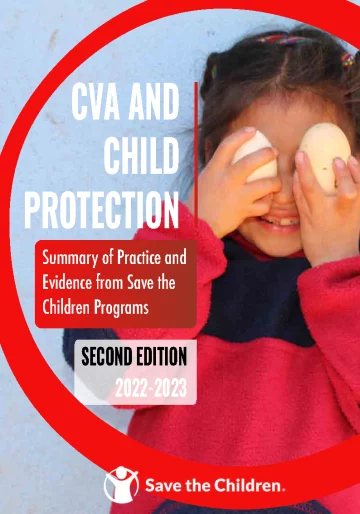
Cash and Vouchers Assistance (CVA) and Child Protection: Summary of practice and evidence from Save the Children programmes 2023 Edition
Report
In an effort to increase global knowledge and learning, Save the Children conducted a global review of twenty Country Offices and their programs in order to assess and highlight the impact that different forms of Cash and Vouchers Assistance (CVA) have on Child Protection (CP) outcomes, to identify...

Social Protection as a Pathway to Sustaining Peace
Policy paper
Global crises are becoming the new normal. From climate change to the contemporary food price crisis, vulnerable populations – and especially rural people – are facing increasingly difficult odds of flourishing. Such challenges are even more pronounced where there is conflict, whose multidimensional...

Exploring linkages between Cash and Voucher Assistance and Social Protection in West and Central Africa
Webinar recording
This is the first in a series of webinars that aims to explore the connections between humanitarian CVA and social protection in West and Central Africa region. The webinar sought to frame the discussion with opening remarks from Dr. Sintike Tarfa Ugbe, Director of Humanitarian & Social Affairs of the...
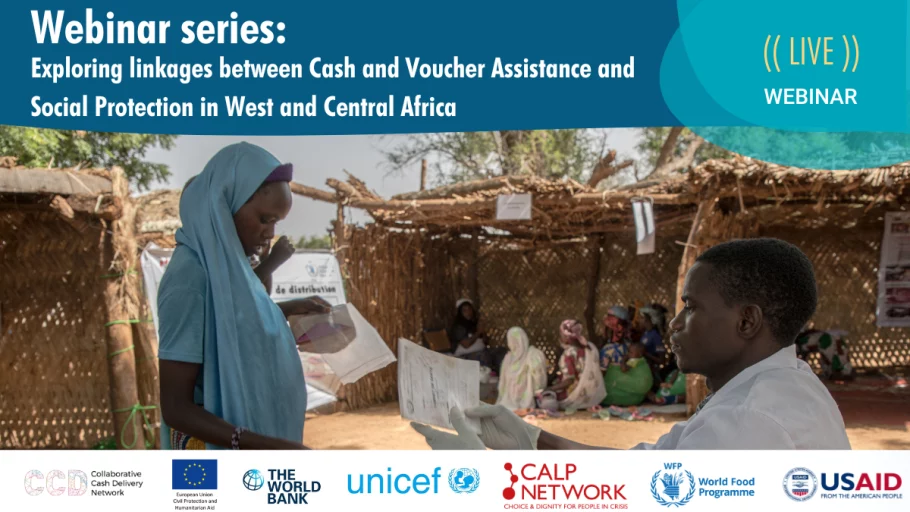
Webinar series: Exploring linkages between Cash and Voucher Assistance and Social Protection in West and Central Africa
Webinar
There was a lot of buzz on the need to link humanitarian assistance to social protection (SP) systems, especially during the COVID pandemic. The linkage should encompass various contexts from stable well-organised states, preferred context by development and social protection stakeholders, to conflict...

Addressing Negative Socioeconomic Impacts of the COVID-19 Pandemic through Social Protection in Viet Nam – Supporting incomes and livelihoods with cash assistance in Dong Nai province
Case Study
In late April 2021, Viet Nam faced its fourth wave of COVID-19, with over 895 000 new cases reported. COVID-19 and related restrictions hindered livelihood options and vulnerable households faced financial stress to cover basic needs. Some of them lost their income and were unable to return to home...

Concept Note: A purpose-driven global fund for scaling digital cash transfers to accelerate progress on ending extreme poverty by 2030
Policy paper
Advances a call for the creation of a new global fund dedicated exclusively to scaling digital cash transfers across low-income countries to accelerate progress on ending extreme poverty by 2030—a structure that would be very similar to GAVI. The working group is building on ideas put forward by...
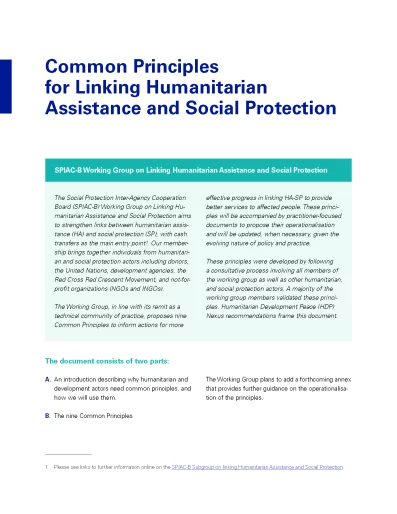
Common Principles for Linking Humanitarian Assistance and Social Protection
Policy paper
The Social Protection Inter-Agency Cooperation Board (SPIAC-B) Working Group on Linking Humanitarian Assistance and Social Protection aims to strengthen links between humanitarian assistance (HA) and social protection (SP), with cash transfers as the main entry point. Our membership brings together...

Just in Time: Advancing anticipatory cash in Pakistan
Guidelines and Tools
Cash and voucher assistance in humanitarian response has grown significantly in recent years, with evidence showing that it supports the agency of recipients, reduces harmful coping strategies, supports local economies, and is a cost-effective form of humanitarian assistance.
The use of cash as a form...
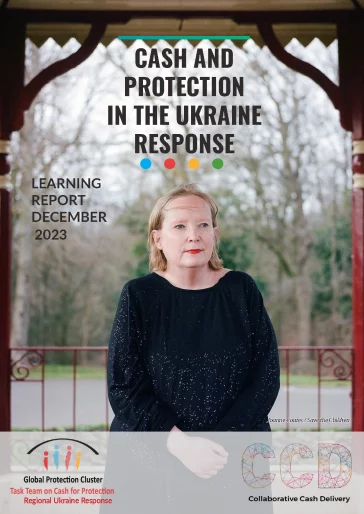
Cash and Protection in the Ukraine Response
Report
This learning report stems from bilateral discussions with the Collaborative Cash Delivery (CCD) Network’s members in Ukraine and Poland, many of whom were on the cusp of designing or implementing C4P programmes as part of the Ukraine response and were seeking learning and experience from each other.
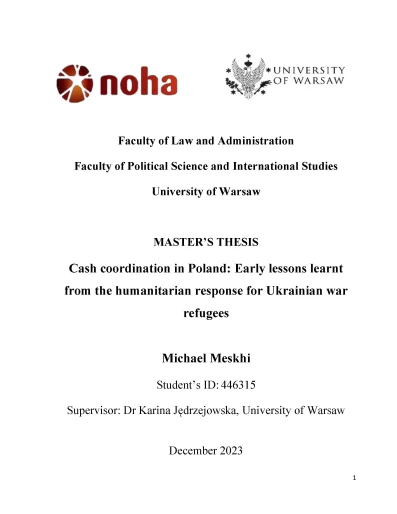
Cash Coordination in Poland: Early lessons learnt from the humanitarian response for Ukrainian war refugees
Case Study
This thesis was submitted for obtaining the Master’s Degree in International Humanitarian Action. By submitting the thesis, the author certifies that the text is from his hand, does not include the work of someone else unless clearly indicated, and that the thesis has been produced in accordance with...

Will our Opinion Matter? Community consultations on the design of multi-purpose cash programmes in Lebanon
Report
Since late 2019, Lebanon has been grappling with a severe economic and financial crisis. The Lebanese lira has lost more than 98 percent of its value, and over half of the Lebanese population is estimated to be living in poverty. The Government of Lebanon and development and humanitarian agencies have...
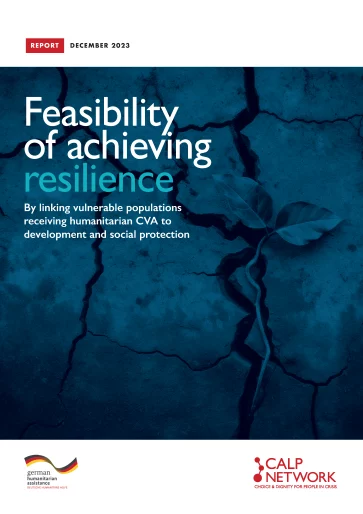
Feasibility of Achieving Resilience by Linking Vulnerable Populations Receiving Humanitarian CVA to Development and Social Protection
Report
This report evaluates the capacities for establishing linkages between humanitarian CVA and state-led social protection in Iraq, Libya and Yemen.

